
A 100 kW diesel engine at WAWZ(FM).
In the aftermath of hurricanes, the topic of emergency power is at the forefront of everyone’s thinking, as it was after Sandy last year. But let a little time pass between emergencies and it’s easy to lapse into an “out of sight, out of mind” mentality.
That is, until another disaster strikes and you’re left hoping that this critical piece of machinery can save you once again.
There are simple steps you can take to ensure that emergency power will be there. It’s not much different from maintaining your own or your station’s vehicles.
OIL CHANGE
For instance, when was the last time you changed the oil in your generator?
When WAWZ(FM) inZarephath, N.J.,ran on generator power for a week after Sandy, Chief Engineer Ron Habegger and I calculated that we’d put the equivalent of nearly 14,000 miles on the engine. Would you drive your car that long between oil changes? (To put this in perspective, that’s more than two round trips from New York to Los Angeles, without taking your foot off the gas.)
If you were on emergency power during recent storms but haven’t given your generator some tender loving care, now’s the time to do so.
Change the oil and coolant. Look for leaky gaskets. Check the belts, hoses and filters. Make sure you have spares on hand. A replacement belt or hose at the parts supplier does you no good when roads are impassable and it’s 2 a.m.
In colder weather, make sure the engine has a properly functioning block heater.
Just like with human bodies, exercise is important in keeping the generator fit and reliable. At WAWZ, we exercise ours once a week for 30 minutes. We monitor fuel level, and we top it off immediately if an extended outage is anticipated.
Keith Smeal is director of technical operations for Greater Media New Jersey. All six of his stations were in Sandy’s path. He outlines his maintenance regimen:
“Each generator is exercised for 15 minutes weekly. They’re also visually inspected for leaks, battery condition and whether any pests — rodents, snakes, insects — have decided to make the generator their home. Each unit has a preventative maintenance service at least once, if not twice annually.”
It’s also important to run the generator under load periodically.
“Once a year, we pull the main breaker in order to have a controlled outage,” says Smeal. This not only assures proper generator operation; it also verifies properly balanced loads.
If you’ve added gear at the site (i.e., additional STLs, HD Radio equipment, etc.), you’ll need to make sure the generator can handle it.
LISTEN
Regular exercise doesn’t accomplish much, however, if you just let it happen in the background. When your generator fires up, do you actually check its performance firsthand?

Bill Clanton, station engineer at WRAT(FM), checks up on the genset. “I have seen far too many people rely on automatic cycling hardware,” says veteran broadcast engineer and consultant David Wilson.
“I highly recommend they listen to it while operating fully loaded. Belts slipping, engine problems, bad fuel, batteries in poor condition can all be caught if someone is paying attention.”
Jay Tee White, vice president of power generation with Cummins Power Systems, says it’s important to have that annual or semi-annual checkup performed by a factory-trained technician.
“While I am sure some individuals will be systematic and consistent, I think the professional technician is going to be more reliable in catching issues. A trained technician follows a maintenance or repair plan outlined by the factory and has the current data on that model and unit.”
Issues such as defective or recalled components can be addressed. If it’s a relatively new generator, problems covered by the warranty can be handled properly.
Your fuel capacity ideally should be enough to keep the generator running for at least a week. Make sure you have a reliable supply chain and that you can reach suppliers in an emergency.
Wilson, having helped stations weather the Nashville flood of 2010, suggests having more than one supplier. Your main supplier may be underwater or otherwise out of commission. Smeal suggests additional temporary storage when a major event is forecast.
If using diesel, be sure to consider additives to prevent problems that arise when fuel is left to sit for long periods. Wilson suggests a tank heater in colder climates. Diesel fuel actually can start to gel at temperatures below 32 degrees Fahrenheit.
Also, it’s not a good idea to fill a nearly empty tank while the engine is running, since new fuel flowing into the tank will stir up all the dirt and gunk that settles to the bottom, allowing it to foul the filters.
WAWZ learned this the hard way after several days on generator power. A few hours after we topped off the tank, the engine began to lose power, as did the site. It was a sinking feeling to see our entire site go dark after we stayed on the air through the worst of the storm. Fortunately, the utility company restored normal power less than an hour after the generator died.
The next morning we changed the fuel filters and all was well.
PUT ONE ON A TRAILER
If you’re in the market for a generator, here’s how to determine your station’s needs.
“Generally, load should be at 80 percent of the generator rating,” Jay Tee White suggests. “Another alternative is to have a sales engineer from a generator supplier perform a survey for you to size the equipment. If you do want to do it yourself, most manufacturers have a sizing tool to help with the process.”
Don’t have the budget for a permanent installation right now? A portable generator, mounted on a trailer, could be a cost-effective option.
“We have some customers who are starting to look at portable units that they can move around in anticipation of the potential loss of power with an automatic transfer switch at each of their installations,” White says. “If they choose incorrectly, they can redeploy the trailer unit quickly. We’re seeing this as a way to spread the investment.”
There are portables than can be rented, even borrowed. Mick Rapeer, chief engineer of WODE(FM), Easton, Pa., maintains a good relationship with a local cable company that let him borrow a 50 kW generator during Sandy.
“We ran only necessary equipment and only auxiliary transmitters on low power for about three days.”
Having such a relationship in place long beforehand can make a world of difference, especially when rentals are scooped up in the wake such an event. Even if the loaner is only large enough to keep your main studio and an exciter on the air, it’s better than nothing.
The station’s emergency generator is as important a piece of equipment as your transmitter. Think about it; in a power outage, if you don’t have a generator, you don’t need a transmitter.
“We so often have redundant systems, but only one generator,” said Smeal.
Curt Yengst, CSRE, is assistant engineer for WAWZ(FM) in Zarephath, N.J. He also works as a freelance recording engineer and assists at WBPH(TV) in Allentown, Pa.












